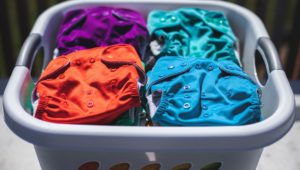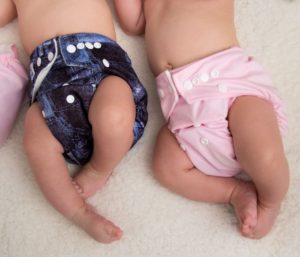
5 Reasons Why You Don’t Really Need Disposable Cloth Diaper Liners

Do you need to use disposable cloth diaper liners for cloth diapering? I am going to share 5 reasons why I don’t use disposable diaper liners. Disposable diaper liners can be expensive to replace each month. They aren’t always 100% effective at preventing soiling of diapers. Disposable liners can clog plumbing and contribute to environmental waste. Reusable diaper liners are also available but are not required for cloth diapering.
Cloth diapering has become an important sub-culture in the realm of motherhood. It is filled with so many choices to make! Whether to use diaper liners is a simple personal choice. I applaud any mother that is loving and taking care of her baby’s needs and totally respect any choice she makes about what products to use!
I have 2 daughters and we have been using cloth diapers since they were infants. I will share why we haven’t used diaper liners, and my simple routine to take care of poopy diapers.

Table of Contents
ToggleReasons I Don’t Use Disposable Cloth Diaper Liners
Reason #1: Disposable Cloth Diaper Liners Can Be Costly
The average cost of disposable diaper liners is .09-.10 each. When you use them for each diaper change, they could cost you up to $240 a year! If you are hoping to save money by doing cloth diapering, this cost can offset the savings you are trying to achieve. With the cost of groceries rising so much this year, saving $15-20 a month to put toward food or household needs could be very helpful.
Reusable liners for easy clean-up can also be purchased or made. These are liners that sit on top of the surface, not an insert. The price range is around $2 per cloth liner. If you wanted to have one for each diaper change you would need at least 20 between washings. This would definitely be more cost-effective long term than disposables. However, I have found that you can take care of dirty diapers without them. I would rather save on buying extra liners and put it toward another set of diapers. We bought our cloth diapers in sets of 6 for around $30.
For more savings on diapering costs, you can read my post about making your own reusable baby wipes.
Reason #2: Disposable Diaper Liners Don’t Always Work
At the beginning of my cloth diapering journey, I tried diaper liners. My little sweetheart loves to move, and the inserts were more often than not getting bunched up in the center of the diaper. An out of place diaper liner is not only uncomfortable for baby, but it doesn’t help to contain the mess when it shifts. I found myself having to clean the diapers anyway. You can read reviews of diaper liners on retail sites where other mothers have had the same issue.
I could have shopped around and tried other brands that may have worked better, but I found I could get by fine without them. Our family tends to favor simplicity and frugality more than extra products. Later in this post, I will share my diaper cleaning routine.
Reason#3: “Flushable” Diaper Liners are Not Always Flushable and can Clog Plumbing
We live in a 1950’s house with older plumbing. Even buying the wrong kind of toilet paper can be problematic and clog our pipes. There is a warning on diaper liners that they are not septic safe and not to use with older plumbing. If they can form a blockage in older plumbing, they can also create a clog in newer plumbing. I love the experiment author Molly Bertsch did in this article
She tested 3 different brands of “flushable liners” in water for 12 hours and none of them dissolved at all. Then she tried putting another test-batch through a wash cycle in her machine. They were all still completely intact after washing.
According to this source, it can cost between $200-$700 for a plumber to fix a clogged toilet depending on where the clog is located and the severity. You can avoid this kind of expense if you don’t flush “flushable” liners, wipes or feminine products.
This means that you can still empty them over the toilet but need to have a way to dispose of the liners in your trash.
Reason #4: Disposable Diaper Liners Still Have a Negative Impact on the Environment.
Using a box of 100 or more liners each month multiplied by the thousands or perhaps millions of families using them creates a lot of waste. The general recommendation for disposable liners is to use one per diaper change. If this is the case, most times when only urine is in the diaper, they were used unnecessarily. The liners are only actually needed a few times a day at most, but it can be hard to predict when to expect a bowel movement.
Even liners marked biodegradable may not totally degrade if they don’t dissolve well in water.
Disposable liners are made of a form of cotton or viscose, rayon or bamboo according to this comprehensive article about liners.
These raw materials must be harvested, manufactured, packaged, transported to a supplier and then transported to the consumer. Although the carbon footprint for a liner is much less than a disposable diaper, it still impacts our environment.

Reason #5: With a Good Diaper Cleaning Routine, Liners are Unnecessary
Here are the steps I follow when I am cleaning up a diaper after a bowel movement. Using this method, I haven’t had any staining and it doesn’t take very much time to take care of.
- Lift up the toilet seat (to avoid unnecessary messes) and dump the solids into the toilet.
- Use a bit of toilet paper to help remove the bulk of any residual solids.
- I slightly dampen the inside of the diaper with water from the sink and place in the small wet bag that came with the diaper set.
- I set it aside until I have time to rinse it out in the laundry tub, sometimes I add to the bag since I have two little ones in need of changing.
- At the end of the day, I spray the soiled diapers (usually just 1 to 2) until mostly clean in my laundry tub. (we have a 3-foot garden hose attached to our laundry faucet which works great as a sprayer) If the inserts inside didn’t get dirty, I place them in the wet bag and they wait in the laundry basket until wash time.
- I place the soiled diapers in a small tub of water with a splash of white vinegar until wash day.
- On wash day, I transfer them from the bucket into the washing machine and run all the diapers through the rinse cycle with some vinegar and detergent added.
- Once rinsed, I can add other laundry to the machine with the diapers for a final regular wash.
Though this sounds like a lot of steps, it only takes a few minutes to take care of dirty diapers at the end of the day. Once it is part of your routine, it will seem very easy.
Our cloth diapers have been used for both of my daughters and have been washed countless times, yet still look like new and show no staining.
What About Using Diaper Creams or Vaseline?
I do use petroleum jelly to help prevent diaper rashes, but haven’t had it impact my cloth diapers. By the time I retrieve them from the washer after having gone through a rinse with some white vinegar and full wash cycle they are residue free.
Diaper creams with zinc can be a different story. This is an instance where a liner would be a great idea. It could be a good idea to keep some cloth or disposable liners or disposable diapers handy in case you need to use a more heavy-duty zinc-based diaper rash cream.
To Use Disposable Cloth Diaper Liners or Not?
This article has outlined some of the reasons why I don’t use disposable cloth diaper liners as well as some steps I take to clean dirty diapers.
Every mama and their situation is different, and the decision to use liners or not is totally a personal choice. I am in favor of whatever you decide to do for your family. I just wanted to provide an alternative view that can still work well and be good for your baby, your budget and your environment. Thank you so much for your time!





